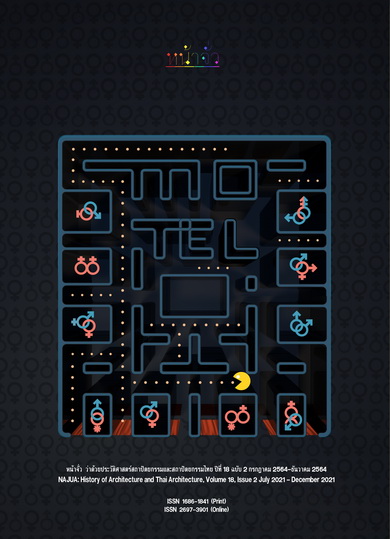Mueang Songkhla Bo Yang: Architectural Styles of Ordination Halls (Ubosot)
Main Article Content
Abstract
The role of Songkhla as a major seaport in the past is an essential attribute for the city's multi-cultural societies, as are evident in the two previous old towns: Huo Khao Daeng and Laem Son, and in Songkhla Bo Yang, the current Municipality. From Ayutthaya to Rathanakosin eras, Songkhla adopted architectural styles from foreign traditions, either central Siam or Chinese, to create Ordination Halls (ubosot) in which decorations made by local craftsmen were also mixed. Such architectural adoption from the external influences reflected the importance of Songkhla as an administrative centre in Southern Siam. This article examines a total of eighteen ordination halls in Songkhla Bo Yang. Drawing upon architectural data and socio-political and cultural contexts, the finding showed that the determining factors of the transformation of the Ubosots' architectural styles derived from historical circumstances, political influences from central Siam, and local building traditions. The architecture of the Ubosots can be classified into four styles: 1) The late Ayutthaya period style 2) The King Rama III's style 3) The Chinese style 4) The royal-traditional standard style.
Downloads
Article Details

This work is licensed under a Creative Commons Attribution-NonCommercial-NoDerivatives 4.0 International License.
References
Fine Arts Department. prawat wat matchimā wā sawa rawi hān čhangwat Songkhlā [History of Wat Matchimawat, Songkhla Province]. Bangkok: Fine Arts Department, 1986.
Local Southern Information. wat matchimāwāt [Wat Matchimawat]. Accessed August 23, 2021. Available from https://clib.psu.ac.th/southerninfo/content/1/2659e681
National Archives in Honour of H.M. Queen Sirikit. lakmư̄ang Songkhlā [Songkhla city pillar]. Accessed September 6, 2021. Available from https://www.finearts.go.th/songkhlaarchives/view/24622
Nattawat Jinrat. “kānʻō̜kbǣp sathāpattayakam bǣp phra rāt niyom nai ratchakān thī sām [The architectural design of King Rama III’s style: The case study of the Buddhist ecclesiastical section of the royal temples in early Ratanakosin period.” Master Thesis, Silpakorn University, 2003.
Phanuphanthuwongworadet, Her Royal Highness Prince. chīwiwat [Traveling to other places]. Bangkok: Kurusapa Business Organization, 1961.
Sakran Jantharat and Sangob Songmuang. kān roēmton læ phatthanākān thāng prawattisāt bōrānnakhadī mư̄ang kao Songkhlā [Beginning and development of Songkhla old town archaeological history]. Bangkok: Fine Arts Department, 1991.
Sangob Songmuang. “mư̄ang Songkhlā (sunlatān sulaimān) Prajao [King Songkhla (Sultan Sulaiman)].” In sārānukrom watthanatham Thai phāk tai phō̜ sō̜ sō̜ngphanhāraʻayayīsipkao [Southern cultural encyclopedia, 1986, volume 13]. 6129-6131. Edited by Suttiwong Pongphaiboon. Bangkok: Amarin Printing, 1986.
Srisak Wanliphodom. “čhāk thā chana thưng Songkhlā [From Thachana to Songkhla].” In khonhā ʻadīt khō̜ng mư̄ang bōrān [Find the past of the ancient city], 52-73. Edited by Namphueng Rattanaaree. Bangkok: Muang Boran Printing. 1995.
Srisamorn Sribenjaplangkul. prawattisāt mư̄ang Songkhlā [Songkhla history]. 2nd ed. Bangkok: Songkhla Rajabhat University, 2011.
Sumate Chumsai Na Autthaya. nam bō̜koēt hǣng watthanatham Thai [Water, provenance of Thai culture]. Bangkok: The Association of Siamese Architects under Royal Patronage, 1996.
Teerayoot Suwaluk. “phra ʻubōsot nai mư̄ang Songkhlā samai kān pokkhrō̜ng khō̜ng čhao mư̄ang trakūn Na Songkhlā phō̜ sō̜ sō̜ngphansāmrō̜isippǣt thưng sō̜ngphan sīrō̜isīsipsī [The Ordination halls in Songkhla under the administration of Na Songkhla rulers family, between C.E. 1775–1901].” Master Thesis, Silpakorn University, 2003.


